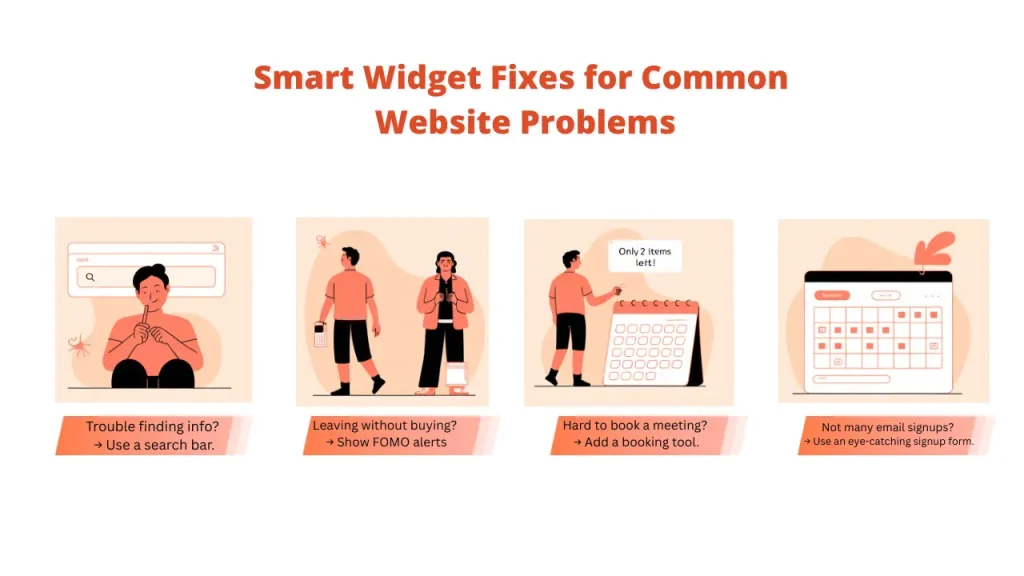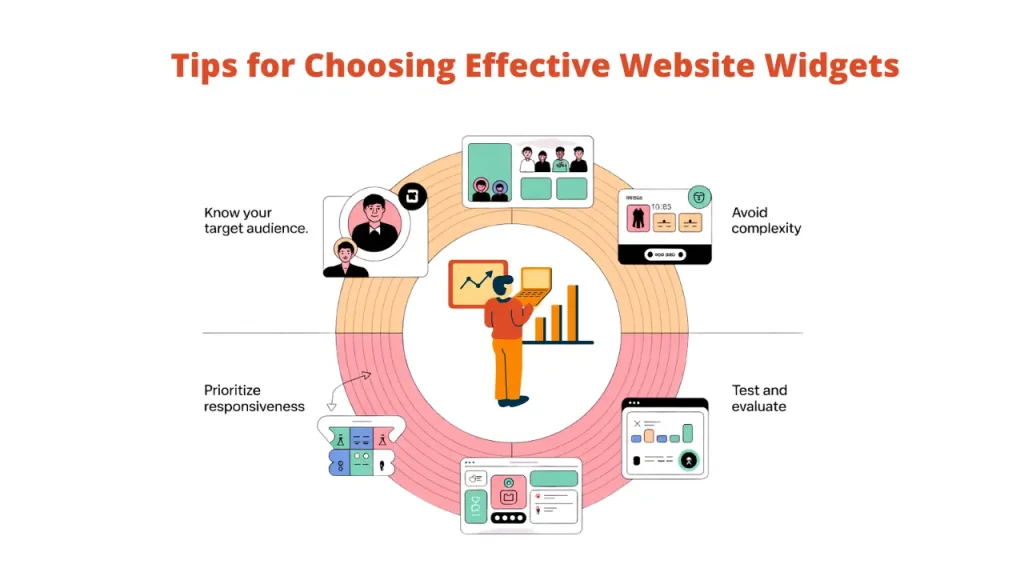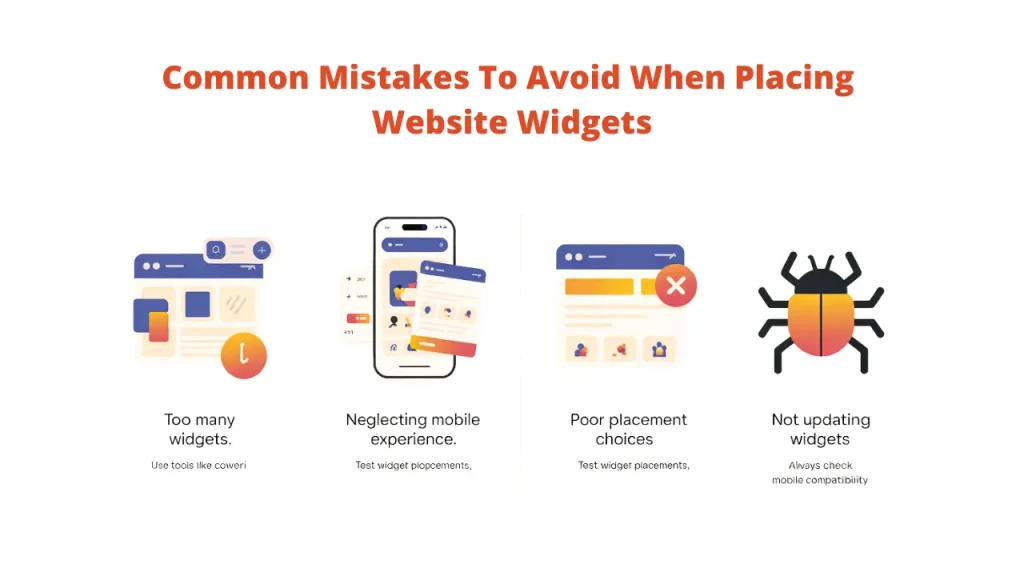There was a time when simply having an online presence meant tapping into an unexplored online market of new leads. But now it’s not enough, having a website has become synonymous with having a business for netizens.
People who visit your site expect more. They want fast loading, simple navigation, trust, and most importantly, to offer something unique from your competitors from the moment they land on your page or they hit exit in just a few seconds.
So, how can you make your website stand out from the crowd without spending a lot of time or learning complicated tech skills?
This is where website widgets can help.
Widgets are small, easy-to-add tools you can place on your site. They help improve how your website works, looks, and feels without needing coding experience.
Think of them as mini-upgrades that make your site smarter and more engaging. The right widgets can grab attention, keep visitors on your site longer, and even turn them into customers.
In this blog, we’ll cover the top 11 website widgets you should consider. These tools can enhance your website’s performance, appearance, and visitor experience.
Why Website Widgets Are Essential in 2025
People using the internet today want more than just good-looking websites. They want helpful pages, easy to use, and react fast. A simple, non-changing website isn’t enough anymore. Visitors now look for live support, up-to-date content, and a personal touch.
How Website Widgets Fix Common Problems

Many common user experience challenges have ready-made widget solutions:
- Trouble finding info? → Use a search bar.
- Leaving without buying? → Show FOMO (fear of missing out) alerts.
- Hard to book a meeting? → Add a booking tool.
- Not many email signups? → Use an eye-catching signup form.
How Website Widgets Give You a Competitive Edge
In 2025, websites with strategically implemented widgets outperform competitors by:
- Reducing friction during the user journey.
- Building trust and driving purchases with customer review pop-ups.
- Gathering valuable user data for continuous improvement.
- Saving time and resources by automating routine tasks.
Tips for Choosing the Right Website Widgets

Choosing the right website widgets isn’t just about knowing what they do. You also need to think about your visitors, what they need, and what you want your website to achieve.
Here are some key tips:
1. Know Your Target Audience
Before implementing a widget, consider your website’s target audience. What is their favorite? What is their browsing style? For example, younger users might enjoy social media features, while business visitors may prefer tools for scheduling or downloading helpful guides.
2. Avoid Complexity
Just because you can add lots of widgets doesn’t mean you should. Each one should have a clear purpose and support your website’s goals. Too many widgets can slow down your site and make it look messy. Tools like Converti help by adding countdown timers and special deals to encourage quick action.
3. Prioritize Responsiveness
Your website widgets should work smoothly on phones, tablets, and computers. Since more people browse on mobile devices, website widgets that don’t adjust properly can hurt the user experience and reduce conversions.
4. Testing and evaluating
After adding widgets, check if they’re actually helping. Are visitors using them? Are they making your site better? If not, replace or remove them. A tool like Converti offers many widget options in one place, so you don’t need lots of separate tools.
The 11 Must-Have Website Widgets

In 2025, website widgets are more than just convenient add-ons—they’re essential for creating a high-performing, user-friendly website. From boosting engagement to improving security and performance, these must-have widgets will help you optimize your site for success.
1. Social Media Feeds & Sharing Widgets
What they do: These tools show your latest social media posts on your website and let visitors easily share your content on different platforms.
Why it matters: Improves brand visibility, increases social engagement, and encourages users to follow your social media channels.
Key advantages:
✅Keep your website fresh by automatically updating it with new social posts
✅Help grow your social media following by showing visitors your active presence
✅Make it easier for people to share your content, increasing your reach
✅Build trust by displaying likes, shares, and other engagement numbers
Recommended tools:
📌 EmbedSocial – Displays social media feeds from multiple platforms in one place
📌 Converti– Offers both social sharing tools and conversion-boosting features
📌 Flockler – Creates shoppable social media feeds and makes it easy to show social proof
2. Live Chat & Customer Support Widgets
What they do: These widgets facilitate real-time communication between visitors and your support team or AI assistants.
Why it matters: Provides instant support, builds trust, and can lead to higher conversion rates.
Key advantages:
✅ Provide quick assistance to prevent visitors from leaving your site.
✅ Answer questions that might stop people from buying
✅ Collect useful customer feedback through chats
✅ Create stronger connections with personalized support
Recommended tools:
📌 Converti – AI-powered chat with smooth human handoff for better engagement
📌 LiveChat – Packed with features like auto-messages and product recommendations
📌 Intercom – Combines chat, bots, and a knowledge base for easy customer support
3. Pop-ups & Lead Generation Widgets
What they do: These website widgets gather visitor data through carefully positioned and timed forms.
Why it matters: Offers immediate assistance, fosters confidence, and may increase conversion rates.
Key advantages:
✅ Turn unknown visitors into potential customers
✅ Highlight special deals, discounts, or exclusive content
✅ Prevent cart abandonment with exit-intent pop-ups
✅ Categorize visitors based on their behavior for better marketing
Recommended tools:
📌 UserFeedback – Creates pop-ups that blend smoothly into the site
📌 ConvertBox – Offers advanced targeting and A/B testing
📌 Hello Bar – A simple but powerful notification bar at the top of the page
4. Reviews & Testimonials Widgets
What they do: Display authentic customer feedback and ratings to build trust with potential customers.
Why it matters: Potential buyers are reassured and influenced by social proof when making purchases.
Key advantages:
✅ Make your brand look trustworthy with real customer feedback.
✅ Answer common doubts by sharing actual user experiences.
✅ Boost sales by making buyers feel more confident.
✅ Highlight product features with customer testimonials.
Recommended tools:
📌 ReviewsOnMyWebsite.com: Gathers reviews from different platforms.
📌 Converti: Shows reviews with pictures and star ratings from real buyers, making them more reliable.
5. SEO & Analytics Website Widgets
What they do: Deliver real-time information straight to your dashboard regarding site performance and visitor behavior.
Why it matters: Helps improve your site using real-time data, making it rank better on search engines.
Key advantages:
✅ Check important stats without leaving your website.
✅ Quickly find ways to improve your site.
✅ See how changes in content and design affect performance.
✅ Use clear data to make better decisions.
Recommended tools:
📌 Google Analytics Dashboard: Connects directly with Google’s tracking system.
📌 Jetpack: Offers WordPress analytics plus security features.
📌 SEO Toolkit: Gives SEO tips and tracks performance.
6. E-Commerce Widgets
What they do: Make shopping easier by showing products, giving suggestions, and improving checkout.
Why it matters: Makes buying smoother, increases sales, and keeps customers happy.
Key advantages:
✅ Sell more by suggesting related products.
✅ Reduce abandoned carts with a simple checkout process.
✅ Encourage quick buying with stock and sale countdowns.
✅ Let customers buy from any page with easy-to-use buy buttons.
Recommended tools:
📌 Shopify Buy Button: Embedded products allow you to sell anywhere.
📌 Ecwid: A complete online store that works on any website.
📌 Snipcart: Turns any website into a shop with e-commerce features.
7. Notification & FOMO Widgets
What they do: Show live notifications to make people feel they need to act fast and trust your brand.
Why it matters: It encourages quick action by making people trust your brand and fear they will miss out.
Key advantages:
✅ Use psychology to boost sales with urgency and social proof.
✅ Make your brand look reliable by showing customer activity.
✅ Push buyers to act quickly with time-sensitive alerts.
✅ Help customers decide faster, increasing sales.
Recommended tools:
📌 Converti: Lets you customize notifications with timers and targeting.
📌 WiserNotify: Automates social proof and provides detailed insights.
📌 Fomo: Shows live events and works with many platforms.
8. Security & Privacy Widgets
What they do: Keep your website and users safe from threats while following privacy rules.
Why it matters: Keeps user data secure and ensures compliance with global privacy laws.
Key advantages:
✅Gain customer trust by showing security badges.
✅ Stop hackers and protect sensitive information.
✅ Follow legal rules and industry standards.
✅ Avoid risks by handling data properly.
Recommended tools:
📌 CookieYes: Manages cookie consent for privacy compliance.
📌 Cloudflare: Shields your site from attacks and security threats.
📌 Wordfence Security: Scans and protects WordPress sites from dangers.
9. Cookie Consent Widgets
What they do: Help website widgets follow privacy laws by managing user permission for data collection.
Why it matters: Prevents legal problems and enhances data collection transparency.
Key advantages:
✅ Follow legal rules in different countries.
✅ Adjust consent settings based on the visitor’s location.
✅ Keep records of user consent for audits.
✅ Earn customer trust by being clear about data use.
Recommended tools:
📌 Converti: Shows a cookie consent message to inform visitors.
📌 CookieYes: Scans and categorizes cookies for full compliance.
📌 Advanced analytics integration: Helps track how consent affects user behavior.
10. Performance Optimization Widgets
What they do: Use a variety of optimization techniques to improve site speed and user experience.
Why it matters: Websites that load faster improve the user experience, reduce bounce rates, and help with search engine optimization.
Key advantages:
✅ Boost SEO rankings by speeding up your site.
✅ Keep visitors on your site longer with smooth performance.
✅ Make sure your site works well on all devices.
✅ Improve speed without losing important features.
Recommended tools:
📌 WP Rocket: Speeds up websites with caching and optimizations.
📌 Autoptimize: Improves site speed by optimizing scripts and styles.
📌 Lazy Load: Loads images and videos only when needed to save resources.
11. Email Subscription Forms
What they do: Capture visitor email addresses for relationship building and marketing purposes.
Why it matters: By keeping your audience interested and informed, email marketing continues to be one of the best return on investment (ROI) tactics.
Key advantages:
✅ Grow your own audience without relying on social media algorithms.
✅ Send automated emails to keep in touch with potential customers.
✅ Organize subscribers based on their interests and actions.
✅ Drive repeat visits with regular email updates.
Recommended tools:
📌 Converti: Gathers emails without being annoying and offers customizable forms with A/B testing.
📌 Thrive Leads: Focuses on conversions with detailed analytics.
📌 Complete GDPR compliance: Ensures users give clear consent before subscribing.
Common Mistakes To Avoid When Placing Website Widgets

Even the top website widgets can backfire if not used correctly. The following are typical errors to look out for:
A. Having Too Many Website Widgets
Website widgets can be helpful, but adding too many can slow down your site and confuse visitors. It’s better to use only the most important ones.
Too many website widgets can:
- Make your website slower
- Looks messy and hard to use
- Distract visitors from what matters
- Cause people to ignore all website widgets (“banner blindness”)
💡 Tip: Tools like Converti give you many features in one place, so you don’t need to use lots of different widgets.
B. Neglecting Mobile Experiences
A widget that looks good on a computer might not work well on a phone. Always check that your widgets work on all screen sizes.
Things to keep in mind for mobile:
- Less space means careful placement
- Buttons should be big enough to tap
- Use fewer animations to save battery
- Keep it simple for better loading on mobile data
C. Poor Placement choices
Where you place a website widget matters. If it’s in the wrong spot, it might annoy users or go unnoticed.
To place widgets correctly:
- Don’t block important pages or steps
- Think about where the visitor is in their journey
- Test different spots to see what works best
- Follow natural reading flow (like top-left to bottom-right in English)
💡 Tip: Users can use Converti to customize widget appearance and behavior to match their brand and needs.
D. Not Updating Your Widgets
Outdated widgets can cause security flaws, bugs, and compatibility issues. To ensure smooth performance, regularly update and monitor your widgets. Widgets on websites are not “set and forget” equipment.
Keep your widgets working well by:
- Doing regular checks
- Updating to the latest versions
- Watching performance data
- Replacing any widget that’s not helping
Conclusion
Using the right website widgets can make a big difference to your website. They can help improve how your site works, make things easier for visitors, and help you get more leads or sales.
In 2025, people expect more from websites. They want fast, helpful, and smooth experiences. The right mix of website widgets can help you give them exactly that. Start by choosing the most useful widgets based on your goals, whether that’s getting more sign-ups, selling more, or helping customers faster.
Keep in mind: quality is better than quantity. Don’t just add widgets for the sake of it. Each one should have a clear purpose and support your visitors’ needs.
Tools like Converti make this even easier. It offers many helpful features in one place, like showing social proof, creating urgency with timers, and helping you turn visitors into real customers.
Looking ahead, website widgets will become even smarter, with more AI, personal touches, and fun experiences. By setting up smart tools now, your site will be ready to grow with the future.




